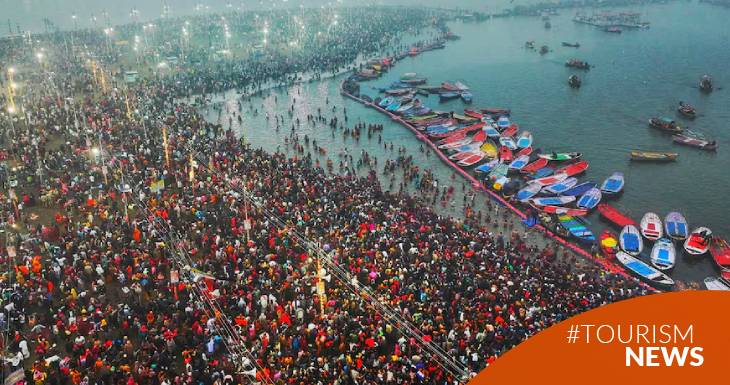The Maha Kumbh Mela, the largest pilgrimage in the world, began with the first mass baths on January 13 in Prayagraj, in which approximately 400 million people will participate until February 26.
The ancient sacred ritual, which combines religious fervour and ritual baths, is celebrated once every 12 years at the place where the sacred rivers Ganges, Yamuna and the mythical Saraswati meet. Hindus believe that immersing oneself in these waters during the Kumbh Mela cleanses sins and brings salvation. The festival is based on a dispute between gods and demons to control a jar with the nectar of immortality. And according to Hindu belief, a drop of this nectar fell in a mythological battle in the four cities hosting the festival, from which the Kumbh Mela festival was born.
To the sound of drums and amid processions of elephants and tractors loaded with statues of Hindu deities, monks dressed entirely in saffron - which in Hinduism indicates the renunciation of material goods and by extension the value of sacrifice - and sadhus, ascetics who follow the rigid path of spiritual discipline with their bodies covered in ash, began to distribute blessings among the first participants.
What does "Kumbh Mela" mean?
"Kumbh Mela" is a Sanskrit expression that literally translates as "Jar Fair" or "Jar Festival", and it is not an organized event with formal invitations, but an ancestral call to which Hindu believers respond out of devotion regardless of their class, caste, or origin.
According to mythology, this bath, especially at the most astrologically propitious time, purifies pilgrims from their sins, frees them from the cycle of reincarnations (samsara) and brings them closer to spiritual liberation (moksha). But in addition to this purification process in water, the Kumbh Mela observes numerous rituals of prayer by the river and religious sermons.
What is the origin of the festival?
According to the Indian Ministry of Culture, the first mentions of the Kumbh Mela date back to the 4th century BC. However, these initial gatherings differ significantly from the massive character that the festival has today. It was after India's independence that the Kumbh Mela gained greater relevance, attracting ever larger crowds and consolidating its cultural significance. In 2017, the festival was recognized as an Intangible Cultural Heritage of Humanity by UNESCO, which described it as “the largest peaceful gathering of pilgrims globally."
Why does it take place every 12 years?
The exact date of the Kumbh Mela is determined by the astrological positions of the Sun, Moon and Jupiter, which are believed to mark an auspicious period for spiritual cleansing and self-enlightenment.
This year's edition will last 45 days, between January 13 and February 26, but the concentration of attendees is not evenly distributed over that period. The festival has six dates especially marked for the sacred bath that usually attract the greatest number of devotees:
- January 13, 14 and 29.
- February 3, 12 and 26.
On these days, the festival can bring together up to 50 million people at a single time, a figure that exceeds the populations of many countries in the world. This is 30 times the population of the city of Prayagraj, inhabited by 1.5 million people the rest of the year.

Who attends the Maha Kumbh Mela?
Most attendees are Hindu devotees who seek to perform ritual ablutions in the holy rivers to purify themselves of their sins and attain salvation. The main religious communities include sadhus (Hindu ascetics), holy men, and members of various spiritual sects.
People also attend from around the world, including Europe, America, and Asia, to experience this unique display of faith and culture.
Many tourists do not necessarily practice Hinduism, but are interested in learning about the tradition, participating in spiritual events, or documenting the experience.
The same is true for researchers from universities and cultural organizations who come to study religious, sociological, and anthropological aspects of the event. The festival offers an unparalleled visual spectacle, with its huge crowds, colorful processions, and unique rituals. This makes it an ideal location for photography and documentary filmmaking.
General Tourism Attractions
Although the main focus is religious, tourists also find interest in:
- Ceremonies and processions: Fascinating performances led by ascetics and spiritual leaders.
- Interaction with sadhus: Many visitors seek to learn about the ascetics and their philosophies.
- Local culture: The fair includes unique food, crafts, and cultural activities.
- Iconic landscapes: Holy rivers, such as the Ganges and Yamuna, are destinations in themselves.
How is India preparing to handle the celebrations?
Even for the world's most populous country of 1.4 billion people, relatively accustomed to the logistics of mass celebrations, hosting the equivalent of the population of the United States and Canada is a tall order. So organizers installed 150,000 toilets, 68,000 streetlights and a tent city on an area two-thirds the size of New York's Manhattan Island.
India's national railway system - Indian Railways - plays a crucial role in bringing tourists and pilgrims closer, so it has added 98 trains to make 3,300 trips to Uttar Pradesh. Temporary trains that operate exclusively during the festival are added to handle the increase in passengers with tickets at affordable prices to facilitate access to people from all social classes. State and private buses also operate additional routes during the festival; Host cities such as Prayagraj Airport receive special flights, and finally many pilgrims undertake long walks as an act of devotion.
The Indian police have deployed significant forces to ensure “maximum security”, with at least 40,000 officers present to help manage the crowds, while surveillance cameras equipped with artificial intelligence capabilities will ensure continuous monitoring.
Kumbh Mela has become an event of enormous significance for Indian society also due to its cultural, social and commercial links, being an event with great appeal, as it includes international tourists and people interested in spirituality, culture and the unique experiences it offers.


